Introduction
Budgerigars, commonly known as budgies or parakeets, are among the most popular pet birds due to their vibrant colors and charming personalities. When it comes to caring for budgerigars with unique colors and patterns, there are some specific tips and tricks that can help ensure these beautiful birds thrive. Whether you’re a seasoned bird owner or new to the world of exotic budgerigar care, understanding the special needs of these colorful companions is essential.
In this guide, we’ll explore everything you need to know about the best diet for budgerigars with unique patterns, proper housing, and grooming tips for exotic budgerigars. By the end of this article, you’ll have a comprehensive understanding of how to provide the best care for your colorful budgies, ensuring they remain healthy and happy.

A vibrant blue budgerigar with intricate feather patterns perched on a wooden stump in a garden setting.
Caring for rare budgerigars isn’t just about aesthetics; it’s about maintaining their health and ensuring they lead fulfilling lives. From diet and nutrition to housing tips for rare budgerigars, we’ll cover it all. So, let’s dive into the fascinating world of budgerigar care and discover how to make your vibrant feathered friends feel right at home.
Understanding Budgerigar Colors and Patterns
Budgerigars, or budgies, are famous for their stunning variety of colors and patterns. These vibrant hues and unique designs aren’t just beautiful; they also add to the charm and appeal of these delightful birds. But what exactly causes these unique budgie patterns and colors?
Budgies come in a wide range of color mutations, including shades of blue, green, yellow, white, and even violet. Each color mutation can have different patterns, such as spangles, pieds, and opalines. These patterns and colors result from specific genetic variations, making each budgerigar unique.
Understanding these colors and patterns is crucial for proper care. Different color mutations can sometimes be more prone to certain health issues. For example, budgerigars with lighter colors like albinos or lutinos might be more sensitive to sunlight and require specific housing conditions to protect their delicate feathers.
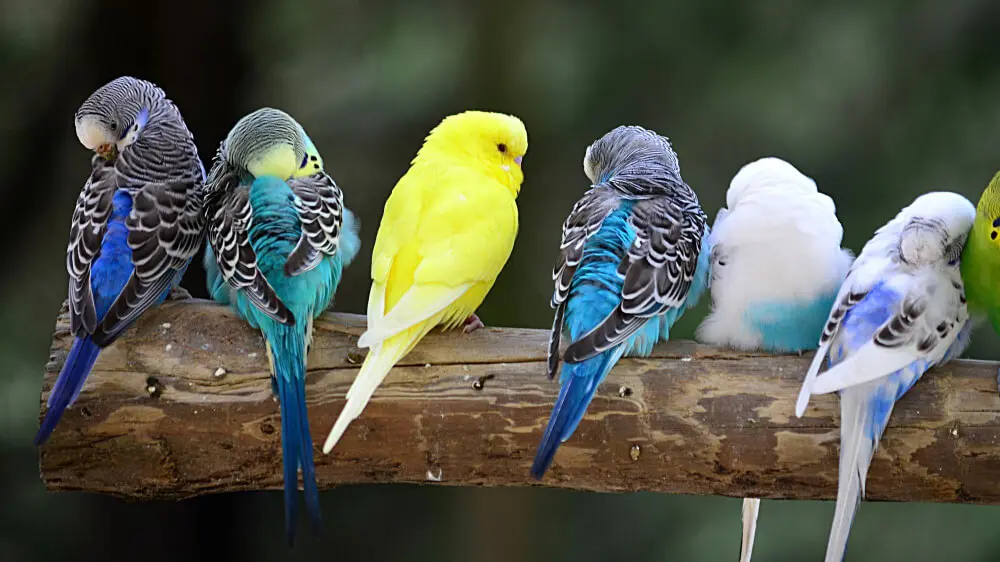
A group of budgerigars with various colors and patterns, including a striking yellow budgerigar, perched together.
When selecting a budgerigar with a unique color or pattern, it’s essential to know the specific care requirements that come with it. This knowledge will help you provide the best possible environment and care for your bird. Whether it’s understanding their dietary needs, the best housing for colorful budgerigars, or grooming exotic budgerigars, each aspect plays a vital role in their overall well-being.
In the following sections, we’ll explore more into these care aspects, offering practical tips and advice for maintaining the health and happiness of your uniquely colored budgerigar. By understanding their colors and patterns, you’re better equipped to meet their specific needs, ensuring they live a long, healthy, and vibrant life.
Importance of Proper Care for Budgerigars with Unique Colors and Patterns
Proper care for budgerigars with unique colors and patterns is crucial for their health and well-being. These colorful budgies often have specific needs that differ from their more common counterparts, making it essential to understand how to care for them effectively.
One of the primary reasons for giving special attention to these exotic budgerigars is their potential susceptibility to certain health issues. For instance, albino and lutino budgerigars can be more sensitive to sunlight, requiring shaded or indoor environments to protect their delicate feathers and skin. Knowing these specific needs helps prevent health problems and ensures your bird remains comfortable and happy.
Diet and nutrition also play a significant role in the health of colorful budgerigars. Unique color mutations might have specific dietary requirements to maintain their vibrant feathers and overall health. Providing a balanced diet rich in essential nutrients is key to keeping these birds in top condition. Knowing what to feed your budgerigar with unique patterns ensures they get the right vitamins and minerals necessary for their specific needs.
Proper housing is another critical aspect of care. Budgies with unique patterns may need particular types of cages or perches to accommodate their size and feather structure. Creating a safe and stimulating environment helps prevent boredom and promotes mental stimulation, which is vital for their well-being.
Grooming and maintenance are also essential for budgerigars with unique colors and patterns. Regular grooming not only keeps their feathers in good condition but also allows you to check for any signs of health issues early on. This proactive approach can make a significant difference in preventing problems before they become serious.
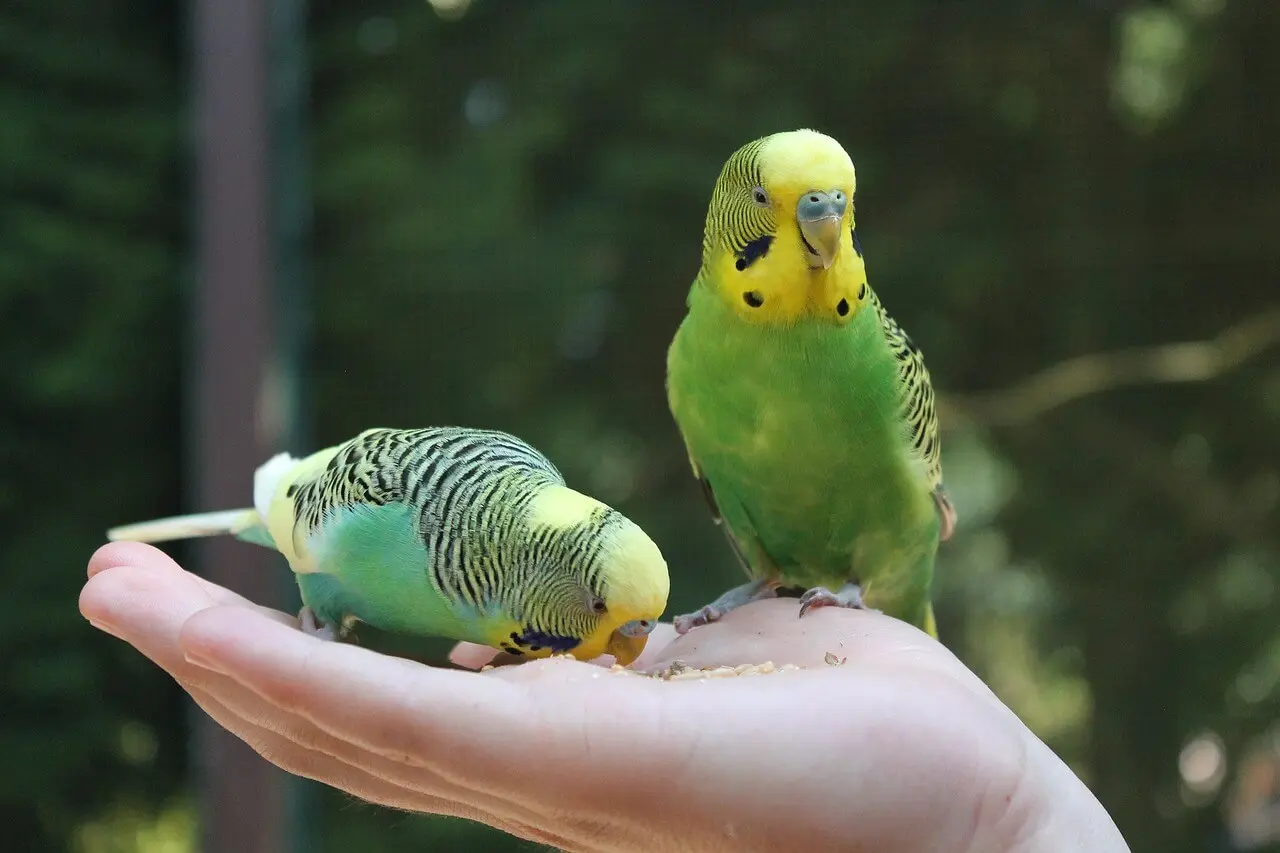
Green and yellow budgerigars enjoying a treat from a hand, illustrating their tame and friendly nature.
In summary, understanding the importance of proper care for budgerigars with unique colors and patterns ensures these beautiful birds lead healthy, happy lives. By addressing their specific needs in terms of diet, housing, and grooming, you can provide the best care possible, ensuring your vibrant feathered friend remains a cherished companion for years to come.
Diet and Nutrition for Budgerigars with Unique Colors
Feeding your budgerigar the right diet is essential, especially when they have unique colors and patterns. Proper nutrition plays a vital role in maintaining the vibrant hues and overall health of these exotic budgerigars.
Balanced Diet
A balanced diet for budgerigars with unique colors should include a mix of seeds, fresh fruits, and vegetables. While seeds are a staple, they should not be the sole component of your budgie’s diet. Incorporating a variety of fresh produce ensures they receive essential vitamins and minerals. Leafy greens like spinach, kale, and parsley are excellent choices, along with fruits like apples, berries, and melons.
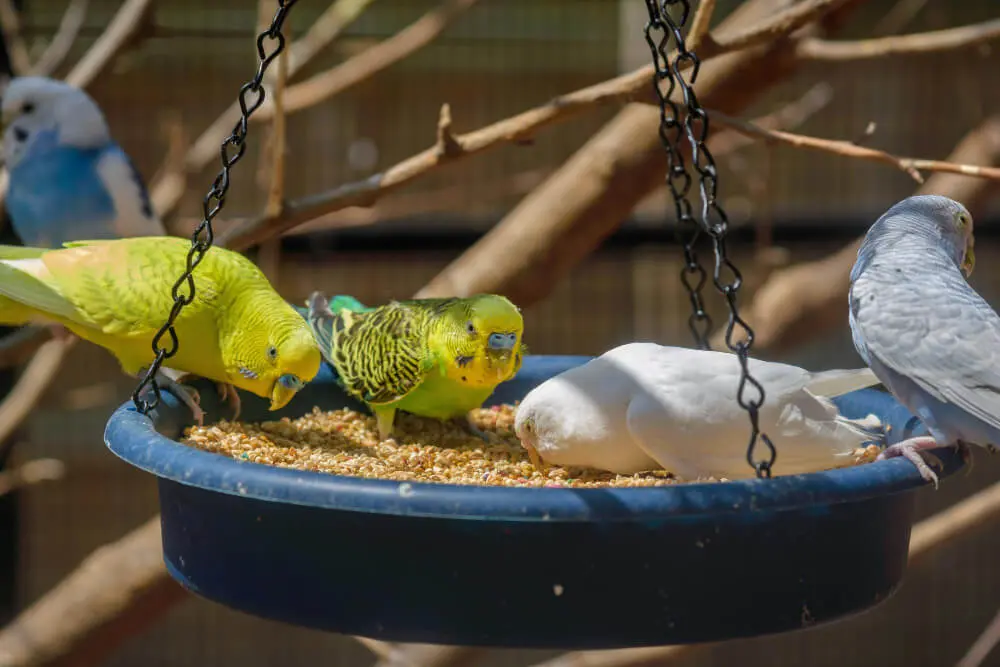
A group of budgerigars with different colors and patterns eating from a hanging feeder, demonstrating their social eating habits.
Pellets
High-quality pellets are another crucial part of a budgerigar’s diet. Pellets are formulated to provide balanced nutrition and can help fill in any gaps left by seeds and fresh foods. Ensure the pellets are specifically designed for budgerigars, as they contain the right balance of nutrients tailored to their needs.
Calcium and Mineral Supplements
Calcium is particularly important for budgerigars, especially those with unique color mutations. Providing cuttlebone or mineral blocks in their cage helps maintain strong bones and beaks. These supplements also offer essential minerals that support overall health and vibrant feather coloration.
Protein
Protein is vital for budgerigars, especially during molting periods when they need extra nutrients for feather regrowth. Boiled eggs, cooked beans, and legumes can be excellent sources of protein. Incorporating these into their diet a few times a week can make a significant difference.
Avoiding Toxic Foods
Certain foods can be harmful to budgerigars, so it’s important to know what to avoid. Avocado, chocolate, caffeine, and alcohol are toxic to birds and should never be given. Also, avoid foods high in salt, sugar, and fat, as they can lead to health issues.
Hydration
Always provide fresh, clean water for your budgerigar. Change the water daily to ensure it’s free from contaminants. Hydration is crucial for digestion and overall health, especially in maintaining the vibrant colors of your budgie’s feathers.
Special Considerations
Budgerigars with unique colors might have specific dietary needs. For example, albino and lutino budgies may require more attention to their diet to prevent deficiencies that could affect their delicate feathers. Consulting with an avian vet can provide personalized recommendations for your bird’s diet.
In conclusion, maintaining a proper diet and nutrition for budgerigars with unique colors is key to their health and vibrant appearance. By offering a balanced diet, incorporating high-quality pellets, providing essential supplements, and ensuring fresh water, you can help your colorful budgerigar thrive and shine.
Housing and Environment Considerations
Providing the right housing and environment for budgerigars with unique colors and patterns is essential for their health and happiness. These vibrant birds thrive in spaces that cater to their physical and mental needs, ensuring they stay active and engaged.
Cage Size and Design
The size of the cage is one of the most critical factors in budgerigar care. For colorful budgerigars, a spacious cage allows them to spread their wings and move around freely. Aim for a cage that is at least 18 inches long, 18 inches wide, and 24 inches high for a single bird. If you have multiple budgies, a larger cage is necessary to prevent overcrowding and stress.
Perches and Toys
Variety in perches is crucial for budgerigars with unique colors. Different textures and diameters help keep their feet healthy and provide mental stimulation. Natural wood perches, rope perches, and even swings can make their environment more engaging.
Toys are another vital component. Budgerigars are intelligent birds that require mental stimulation to prevent boredom. Provide a mix of chew toys, bells, and mirrors. Rotate the toys regularly to keep your budgie interested and entertained.

A vibrant yellow budgerigar and a white budgerigar perched in a cage equipped with engaging toys and perches, showcasing their unique colors and playful environment.
Light and Temperature
Proper lighting is essential, especially for budgerigars with unique patterns and colors. Ensure they get natural sunlight or provide full-spectrum lighting to simulate natural conditions. This helps maintain their circadian rhythm and supports overall health.
Temperature control is also crucial. Budgerigars are sensitive to extreme temperatures. Keep their environment between 65-75°F (18-24°C) and avoid sudden temperature changes. Placing the cage away from drafts, direct sunlight, and heating vents helps create a stable environment.
Cleanliness
Maintaining a clean cage is vital for the health of your budgerigar. Clean the cage floor daily and change the lining to prevent the buildup of droppings and bacteria. Wash food and water dishes daily to ensure they remain free from contaminants.
Safe and Enriching Environment
A safe environment extends beyond the cage. Supervised playtime outside the cage can provide additional enrichment. Ensure the room is bird-proofed by removing potential hazards like toxic plants, open windows, and electrical cords.
Social Interaction
Budgerigars with unique colors and patterns often thrive on social interaction. If you have a single bird, spending time with them daily is essential. Budgies are social creatures that enjoy companionship, whether it’s from their human caretakers or other budgerigars. Consider getting a second budgie if you’re often away, as having a companion can significantly improve their quality of life.
Special Considerations
Certain color mutations, like albinos or lutinos, may have specific housing needs due to their sensitivity to light. These budgies might benefit from additional shading in their environment to protect their feathers and skin.
In conclusion, providing the right housing and environment for budgerigars with unique colors and patterns is crucial for their well-being. By focusing on cage size, perches, toys, lighting, temperature, cleanliness, and social interaction, you can create a safe and enriching space for your colorful feathered friend. This ensures they remain healthy, happy, and vibrant for years to come.
Health and Wellness Tips
Maintaining the health and wellness of budgerigars with unique colors and patterns requires a proactive approach. These vibrant birds can be more susceptible to certain health issues, so it’s important to know how to keep them in top condition.
Regular Vet Check-Ups
One of the best ways to ensure your budgerigar stays healthy is through regular vet check-ups. Annual visits to an avian vet can help catch any potential issues early. This is especially important for budgies with unique color mutations, as they might have specific health concerns.

A veterinarian carefully examining a budgerigar, ensuring its health and well-being.
Balanced Diet
As mentioned in the diet and nutrition section, providing a balanced diet is crucial. A mix of seeds, pellets, fresh fruits, and vegetables ensures your budgie gets all the necessary nutrients. Avoid feeding them harmful foods like chocolate, avocado, and caffeine, which can be toxic.
Clean Living Environment
A clean living environment is essential for preventing diseases. Regularly clean the cage, food dishes, and water bowls. Ensure the cage is free from mold and bacteria by changing the cage liner daily and disinfecting the cage weekly.
Monitor Behavior and Appearance
Keep an eye on your budgerigar’s behavior and appearance. Any changes, such as lethargy, loss of appetite, or changes in feather condition, can indicate health issues. Early detection can make a significant difference in treatment outcomes.
Provide Mental Stimulation
Mental stimulation is important for your budgie’s overall wellness. Provide toys, perches, and regular interaction to keep your bird engaged. A bored budgie can develop behavioral issues, such as feather plucking or aggression.
Proper Grooming
Grooming is vital for maintaining your budgerigar’s beautiful feathers. Regularly check their feathers for signs of mites or other parasites. Provide a shallow dish of water for your budgie to bathe in, or mist them with water to help keep their feathers clean and healthy.
Safe Exercise
Exercise is essential for your budgerigar’s health. Allow them supervised time outside the cage to fly and explore. Ensure the room is safe and free from hazards like open windows, ceiling fans, and toxic plants.
Preventing Common Health Issues
Budgerigars with unique colors and patterns can be prone to specific health issues, such as respiratory problems and skin sensitivity. Ensure they are kept in a draft-free environment and monitor the humidity levels to prevent respiratory issues. For skin sensitivity, provide shaded areas to protect lighter-colored birds from excessive sunlight.
Social Interaction
Budgerigars are social creatures and need regular interaction. If you have a single budgie, spend time with them daily. Social interaction helps prevent loneliness and depression, contributing to overall wellness.
Special Considerations
For budgerigars with unique colors, like albinos or lutinos, extra care might be needed. These birds can be more sensitive to light and may require additional shading or a more controlled environment to protect their delicate feathers and skin.
In conclusion, ensuring the health and wellness of budgerigars with unique colors and patterns involves a combination of regular vet check-ups, a balanced diet, a clean environment, mental stimulation, proper grooming, safe exercise, and social interaction. By following these tips, you can help your colorful budgie live a long, healthy, and happy life.
Grooming and Maintenance
Proper grooming and maintenance are essential for keeping budgerigars with unique colors and patterns healthy and looking their best. These vibrant birds need regular care to maintain their beautiful feathers and overall well-being. Here are some tips to help you keep your colorful budgerigar in top condition.
Feather Care
Feathers are a key part of what makes budgerigars so visually appealing. To keep their feathers in prime condition, provide a shallow dish of water for bathing. Bathing helps remove dirt and dust, and many budgies enjoy splashing around. You can also mist them gently with water using a spray bottle. Ensure the water is lukewarm and free of any additives.

A green budgerigar enjoying a bath in a green bird bath, promoting hygiene and well-being.
Beak and Nail Trimming
Overgrown beaks and nails can cause discomfort and health issues for your budgie. Provide natural wood perches and cuttlebone to help keep their beak trimmed naturally. If your budgie’s beak or nails become overgrown, it may be necessary to trim them. This should be done carefully, and if you’re unsure, seek help from an avian vet to avoid injury.
Regular Health Checks
Regular health checks are an important part of grooming and maintenance. Look for signs of parasites, such as mites, which can affect your budgie’s skin and feathers. If you notice any unusual behavior or physical changes, consult your vet promptly. Early detection of issues is crucial for effective treatment.
Environmental Hygiene
Maintaining a clean environment is vital for your budgerigar’s health. Clean the cage regularly to prevent the buildup of bacteria and mold. Change the cage liner daily and disinfect the cage and accessories weekly. Clean food and water dishes daily to ensure they remain free of harmful contaminants.
Molting Periods
During molting periods, budgerigars shed old feathers and grow new ones. This is a natural process but can be stressful for your bird. Ensure they have a balanced diet rich in protein and vitamins to support feather growth. You might also notice your budgie preening more frequently to remove old feathers and keep new ones in good condition.
Special Considerations for Unique Colors
Budgerigars with unique colors, like albinos and lutinos, may require extra care. Their feathers can be more sensitive, so avoid harsh chemicals or excessive handling that could damage them. Providing a shaded area in their cage helps protect these lighter-colored birds from direct sunlight, which can harm their delicate feathers and skin.
Social Grooming
Budgies are social animals and often groom each other as a form of bonding. If you have more than one budgie, you may notice them preening each other’s feathers. This social grooming helps keep their feathers in good condition and strengthens their bond.
Enrichment and Toys
Providing enrichment through toys and perches not only keeps your budgie mentally stimulated but also helps with grooming. Chew toys and natural wood perches can help wear down their beak and nails naturally. Rotate toys regularly to keep your budgie engaged and active.
Grooming and maintenance are crucial for the health and beauty of budgerigars with unique colors and patterns. By following these tips and paying close attention to their needs, you can ensure your vibrant budgie stays healthy, happy, and looking its best. Regular care, a clean environment, and attention to their unique requirements will help your colorful feathered friend thrive.
Socialization and Mental Stimulation
Socialization and mental stimulation are key components in caring for budgerigars with unique colors and patterns. These intelligent and social birds need regular interaction and engaging activities to maintain their well-being and prevent boredom.
The Importance of Socialization
Budgerigars are naturally social creatures. In the wild, they live in large flocks and engage in constant interaction. For pet budgies, socialization is crucial to their happiness. If you have a single budgerigar, spend time with them daily. Talk to them, play with them, and let them perch on your finger. This interaction helps build a strong bond and keeps your budgie emotionally healthy.
If you have more than one budgerigar, they will naturally socialize with each other. However, they still benefit from human interaction. Engaging with your birds regularly strengthens your relationship and ensures they remain friendly and tame.
Providing Mental Stimulation
Mental stimulation is vital for budgerigars, especially those with unique colors and patterns who may have specific needs. Providing a variety of toys and activities keeps their minds active and prevents boredom, which can lead to behavioral issues.
Toys and Enrichment
Offer a range of toys to keep your budgie entertained. Toys with different textures, shapes, and colors are great for stimulating their senses. Puzzle toys that hide treats can also challenge your budgie’s problem-solving skills. Rotate the toys regularly to keep things fresh and exciting.
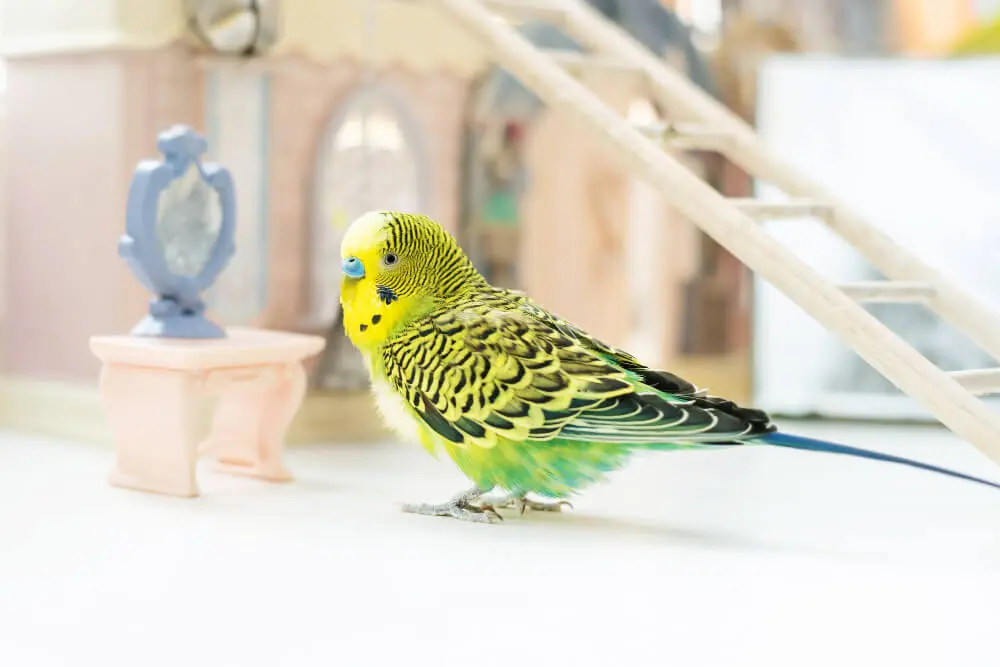
A green budgerigar exploring its play area, which includes toys and perches for stimulation.
Foraging Activities
Foraging is a natural behavior for budgerigars. Create foraging opportunities by hiding their favorite treats in toys or around their cage. This encourages them to use their natural instincts and provides mental stimulation.
Training and Tricks
Training your budgerigar to perform simple tricks is another excellent way to provide mental stimulation. Start with basic commands like “step up” and gradually introduce more complex tricks. Training sessions are not only mentally engaging but also a great way to strengthen your bond.
Safe Out-of-Cage Time
Allowing your budgerigar supervised time outside the cage provides physical and mental stimulation. Ensure the room is safe and bird-proofed, with windows closed and no toxic plants or other hazards. This free-flight time helps keep your budgie active and curious.
Social Interaction with Other Birds
If you have multiple budgerigars, they will naturally interact with each other, providing social and mental stimulation. Watching them play, preen, and communicate can be incredibly rewarding. If you have a single budgie and cannot provide constant interaction, consider getting a second budgerigar to keep them company.
Music and Sounds
Budgerigars enjoy sounds and music. Playing gentle music or nature sounds can be soothing and stimulating for your bird. Some budgies even enjoy mimicking the sounds they hear, adding to their mental engagement.
Special Considerations
Budgerigars with unique colors and patterns might have specific social and mental needs. Pay attention to their behavior and adjust their environment and interactions accordingly. For instance, more timid birds might need gradual introductions to new toys or activities.
Ensuring proper socialization and mental stimulation for budgerigars with unique colors and patterns is crucial for their overall well-being. By providing a variety of toys, regular interaction, training, and safe out-of-cage time, you can keep your budgie happy, healthy, and mentally stimulated. These efforts will lead to a more fulfilling life for your colorful and vibrant feathered friend.
Common Issues and How to Address Them
Caring for budgerigars with unique colors and patterns can present specific challenges. Being aware of common issues and knowing how to address them is crucial for maintaining the health and happiness of your colorful feathered friend. Here are some common problems and practical solutions.
Feather Plucking
Feather plucking is a common issue among budgerigars and can be particularly concerning for those with unique colors and patterns. This behavior often indicates stress, boredom, or health issues.
How to Address:
- Ensure Proper Diet: A balanced diet rich in nutrients can help maintain healthy feathers.
- Provide Mental Stimulation: Toys, foraging activities, and interaction can prevent boredom.
- Check for Health Issues: Consult an avian vet to rule out medical causes like mites or skin infections.
- Reduce Stress: Keep their environment calm and stable. Avoid sudden changes in their surroundings.
Respiratory Problems
Budgerigars with unique colors, such as albinos and lutinos, might be more prone to respiratory issues due to their sensitivity to environmental changes.
How to Address:
- Maintain Cleanliness: Regularly clean the cage and ensure good ventilation.
- Avoid Drafts: Place the cage in a draft-free area.
- Monitor Humidity: Keep the humidity levels between 40-60% to support respiratory health.
- Seek Veterinary Care: If you notice symptoms like wheezing or labored breathing, consult an avian vet promptly.
Skin Sensitivity
Certain color mutations may have more delicate skin, making them susceptible to irritations and infections.
How to Address:
- Provide Shade: Ensure they have shaded areas in their cage to avoid direct sunlight.
- Regular Bathing: Offer regular baths or mist them with water to keep their skin hydrated.
- Use Mild Cleaners: Clean their cage with mild, bird-safe cleaners to avoid skin irritation.
Obesity
Budgerigars with unique colors can be prone to obesity if their diet is not properly managed.
How to Address:
- Monitor Diet: Provide a balanced diet with limited seeds and more fresh fruits and vegetables.
- Encourage Exercise: Ensure they have enough space to fly and play. Out-of-cage time is crucial.
- Avoid High-Fat Foods: Limit treats like sunflower seeds and nuts, which are high in fat.
Behavioral Issues
Budgerigars are social and intelligent birds, and without proper interaction, they can develop behavioral issues such as aggression or excessive screaming.
How to Address:
- Increase Social Interaction: Spend time with your budgie daily. If you have a single bird, consider getting a companion.
- Provide Mental Stimulation: Regularly rotate toys and introduce new activities.
- Create a Routine: Budgerigars thrive on routine. Regular feeding and play times can reduce stress and behavioral problems.
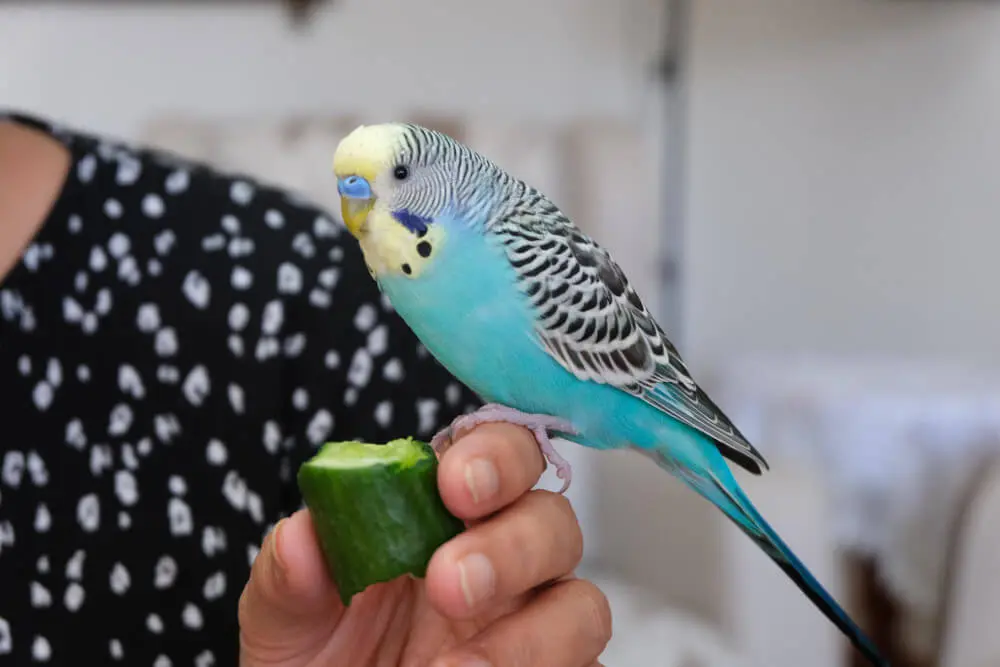
A vibrant blue budgerigar shares a social moment with its owner while enjoying a fresh piece of cucumber.
Malnutrition
Budgerigars with unique colors might have specific dietary needs, and malnutrition can lead to serious health issues.
How to Address:
- Balanced Diet: Ensure their diet includes a mix of seeds, pellets, fresh fruits, and vegetables.
- Supplements: Provide necessary supplements like cuttlebone for calcium.
- Monitor Eating Habits: Keep an eye on their eating habits and consult a vet if you notice changes.
Stress
Stress can affect budgerigars with unique colors and patterns more severely, leading to various health and behavioral issues.
How to Address:
- Stable Environment: Keep their environment stable and free from loud noises and sudden changes.
- Comfortable Cage Setup: Ensure their cage is spacious, well-lit, and has plenty of perches and toys.
- Regular Interaction: Spend quality time with your budgie to build trust and reduce anxiety.
Understanding and addressing common issues in budgerigars with unique colors and patterns is essential for their well-being. By providing proper diet, mental stimulation, clean living conditions, and regular veterinary care, you can ensure your vibrant feathered friend remains healthy and happy. Recognizing the signs of common problems early and taking proactive steps to address them will help your budgie lead a long and fulfilling life.
Frequently Asked Questions (FAQs)
What is the best diet for budgerigars with unique colors and patterns?
A balanced diet is crucial for budgerigars with unique colors and patterns. Provide a mix of high-quality seeds, pellets, fresh fruits, and vegetables. Avoid foods that are high in fat, like sunflower seeds, and ensure they have access to fresh, clean water daily. Including cuttlebone and mineral blocks can help provide essential nutrients like calcium.
How can I keep my colorful budgerigar’s feathers healthy?
To keep your budgerigar’s feathers healthy, ensure they have regular access to a shallow dish of water for bathing or mist them gently with water. Provide a balanced diet rich in vitamins and minerals, and make sure their living environment is clean. Regular vet check-ups can also help catch any potential issues early.
Are there specific housing requirements for budgerigars with unique colors?
Yes, budgerigars with unique colors, especially lighter ones like albinos and lutinos, may need additional protection from direct sunlight. Ensure their cage is spacious, well-ventilated, and placed in a draft-free area. Providing shaded areas within their cage can help protect sensitive skin and feathers.
How can I provide mental stimulation for my budgerigar?
Mental stimulation is essential for budgerigars. Offer a variety of toys with different textures, shapes, and colors. Puzzle toys that hide treats can engage their problem-solving skills. Rotate toys regularly to keep their environment interesting, and provide opportunities for foraging by hiding treats around the cage.
What are common health issues in budgerigars with unique colors and patterns?
Common health issues in budgerigars with unique colors and patterns include feather plucking, respiratory problems, and skin sensitivity. Regular vet check-ups, a balanced diet, a clean living environment, and monitoring their behavior can help prevent and address these issues promptly.
How often should I take my budgerigar to the vet?
It’s recommended to take your budgerigar for an annual vet check-up. However, if you notice any changes in their behavior, eating habits, or appearance, it’s important to consult an avian vet immediately. Regular check-ups can help catch potential health issues early.
Can I keep a single budgerigar, or do they need a companion?
While budgerigars are social birds that thrive on interaction, it is possible to keep a single budgie if you can spend a lot of time interacting with them. However, having a companion budgie can significantly improve their quality of life, providing social interaction and preventing loneliness.
How do I trim my budgerigar’s beak and nails?
Budgerigars often keep their beaks and nails trimmed through natural activities like chewing on cuttlebone and using perches. If trimming is necessary, it should be done carefully to avoid injury. Consult an avian vet if you’re unsure how to trim your budgie’s beak or nails safely.
What should I do if my budgerigar starts feather plucking?
Feather plucking can be caused by stress, boredom, or health issues. Ensure your budgerigar has a balanced diet, plenty of toys and mental stimulation, and a clean environment. If the behavior persists, consult an avian vet to rule out medical causes and get advice on behavioral interventions.
How can I tell if my budgerigar is stressed?
Signs of stress in budgerigars include feather plucking, loss of appetite, excessive screaming, and changes in behavior. Ensure they have a stable, calm environment, regular social interaction, and plenty of mental stimulation to reduce stress. If symptoms persist, seek advice from an avian vet.
These FAQs should help you address common questions and concerns about caring for budgerigars with unique colors and patterns, ensuring your vibrant feathered friend stays healthy and happy.
Conclusion
Caring for budgerigars with unique colors and patterns requires a thoughtful approach, but the rewards are well worth the effort. By understanding their specific needs, from diet and housing to socialization and grooming, you can ensure your colorful budgie thrives.
Proper care involves providing a balanced diet rich in nutrients, creating a clean and stimulating environment, and offering regular social interaction. It’s essential to monitor their health closely and address any issues promptly to keep your budgie happy and healthy. Regular vet check-ups, mental stimulation, and maintaining a clean living space are crucial components of their care.
Each budgerigar is unique, and those with special color mutations might have specific needs that require extra attention. By following the tips and guidelines outlined in this guide, you can provide the best possible care for your vibrant feathered friend.

A green budgerigar perched on a finger, showcasing its tame and friendly disposition.
Remember, a healthy and happy budgie is a joy to have, bringing color and life into your home. With the right care and attention, your budgerigar with unique colors and patterns will not only survive but thrive, brightening your days with their cheerful presence and beautiful plumage.

